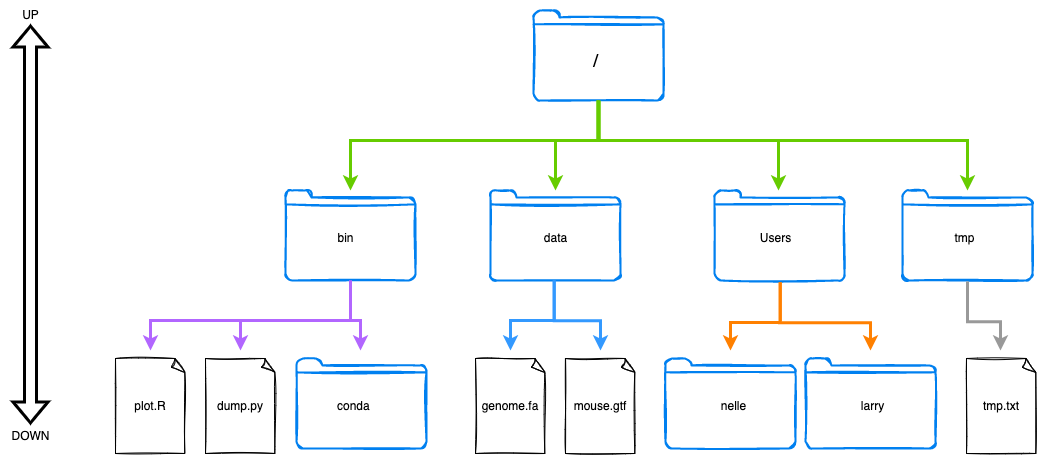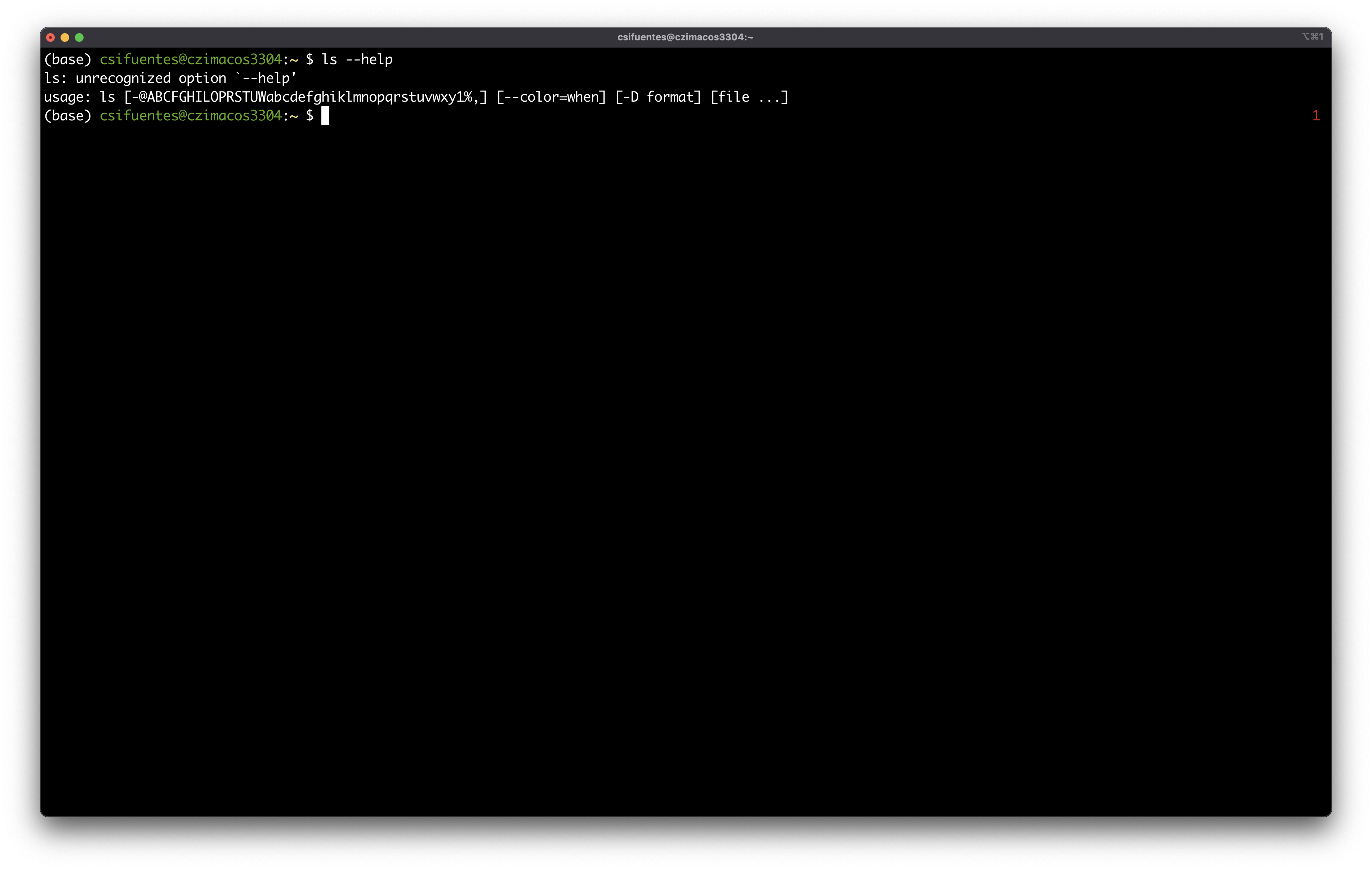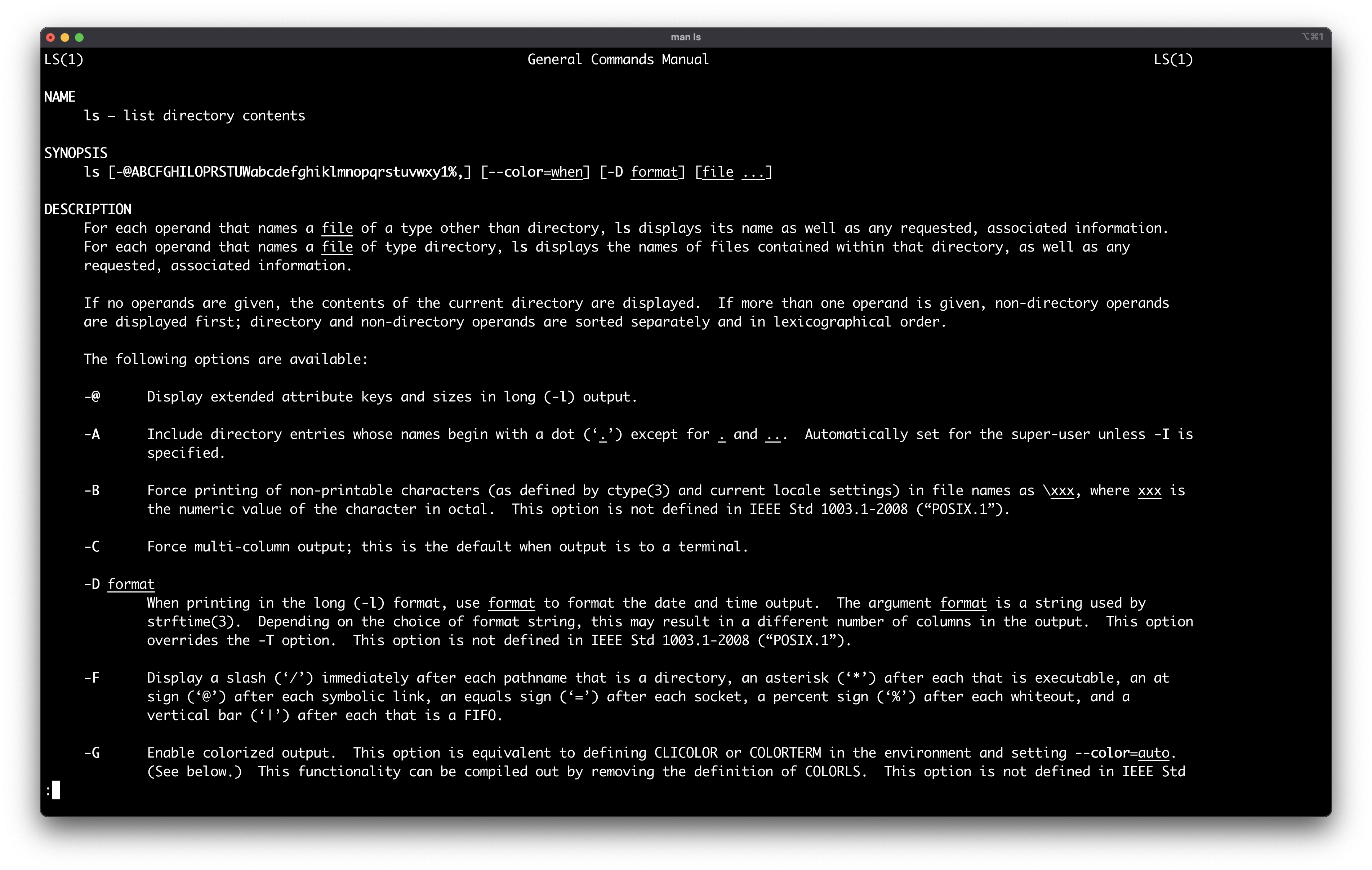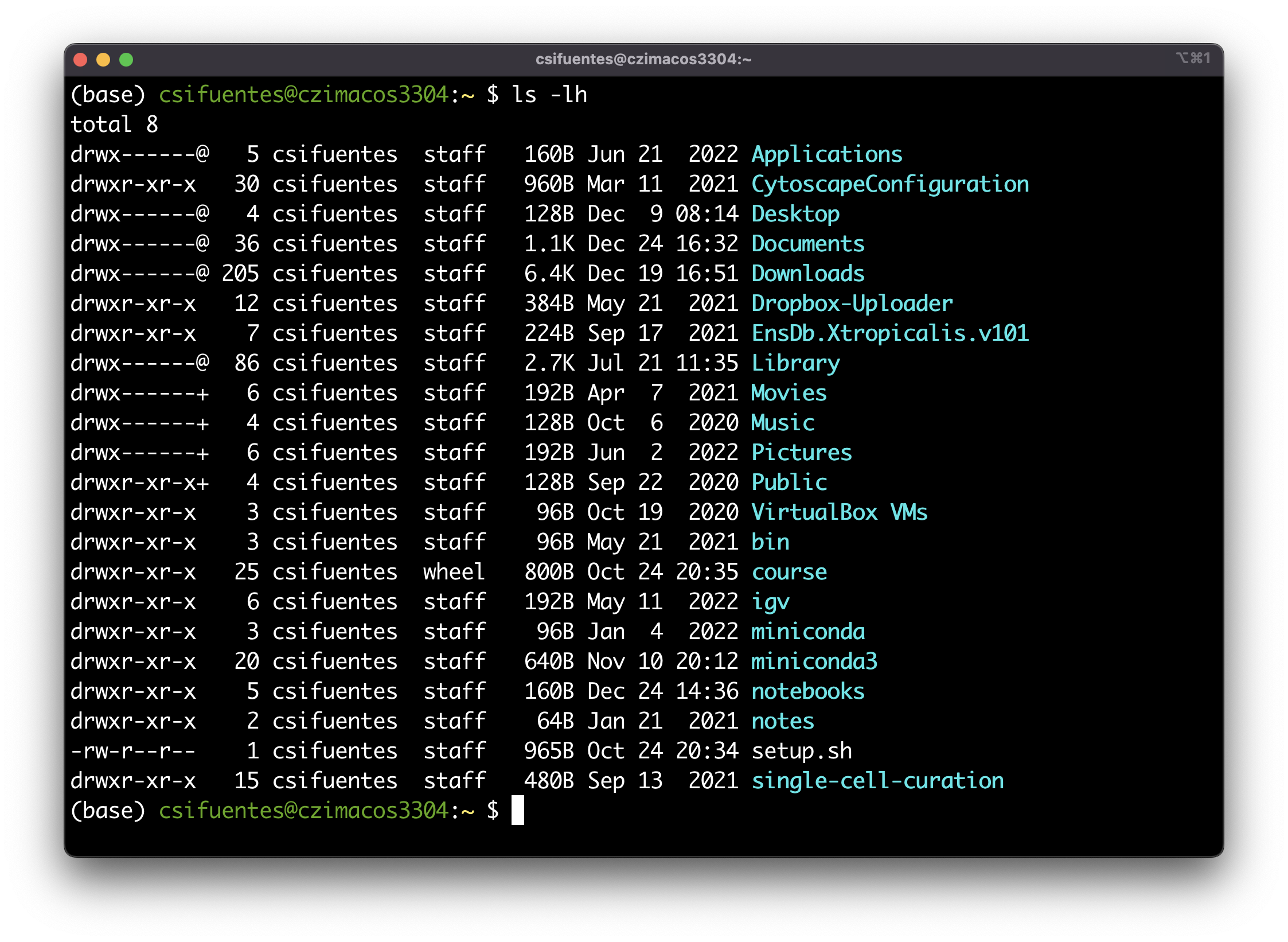Working with Files and Directories
File System
The file system manages and organizes our files and directories.
- Files contain information, such as text or images.
- Directories (what we often refer to as folders) contain files and other directories.

Directories and paths
As we saw above in Figure 1., the file system is a set of directories and files. We can think of
When we work in the command line, we are working in a specific location of the file system, called the “working directory”.
How do we know where we are? We can use a command for that.
pwd command
pwdstands for print working directory- prints out working directory location to the screen
The location within the file system is also called path, because it tells that path that can be taken from the top-most directory to the specified location.
Let’s try it. Run the pwd command in your terminal.
bash-3.2$ pwd
/Users/csifuentes
bash-3.2$In the response above, the path of my working directory is /Users/csifuentes.
Structure
Below is a schematic representing the file system for three users: Imhotep, Larry, and Nelle.
What do you think the user paths will be?

For Imhotep: /Users/imhotep
For Larry: /Users/larry
For Nelle: /Users/nelle
Using the examples above, let’s break down the path structures. If we look at directories, we see there are
| Directory | |
|---|---|
| Top level | / or root |
| Next one down | bin, data, Users, and tmp |
| Lowest level (home directories in this case) | imhotep, larry, and nelle |
Listing files and directories
When we’re using a terminal and in a specific directory, we often want to know which files and directories are in our currint working directory. How can we do that?
We use the ls command.
Let’s try it. Run the ls command in your terminal.
bash-3.2$ ls
Applications Movies RNASeq
Desktop Music SoftwareCarpentryStuffs
Documents Pictures VirtualBox VMs
Downloads Public miniconda3
Library RNASeqAnalysis.R notes
bash-3.2$That didn’t work right Let’s modify the the behavior of the ls command using the -F flag to list formats.
(base) czimacos3304:~ csifuentes$ ls -F
Applications/ Downloads/ Movies/ VirtualBox VMs/ miniconda/ setup.sh
CytoscapeConfiguration/ Dropbox-Uploader/ Music/ bin/ miniconda3/ single-cell-curation/
Desktop/ EnsDb.Xtropicalis.v101/ Pictures/ course/ notebooks/
Documents/ Library/ Public/ igv/ notes/In the output, we see trailing symbols
- / means the preceding is a directory
- @ means the preceding is a link
- files will have nothing preceding
Cleaning up
As we work in the terminal commands and outputs are printed to the screen. At times this becomes messy and it will take up the entire terminal screen, in time. We can clear the terminal using the clear commmand.
clear command
clearstands for clear :)- clears the current terminal shell session
(base) czimacos3304:~ csifuentes$ ls
Applications Downloads Movies VirtualBox VMs miniconda setup.sh
CytoscapeConfiguration Dropbox-Uploader Music bin miniconda3 single-cell-curation
Desktop EnsDb.Xtropicalis.v101 Pictures course notebooks
Documents Library Public igv notes
(base) czimacos3304:~ csifuentes$ ks
bash: ks: command not found
(base) czimacos3304:~ csifuentes$ ls
Applications Downloads Movies VirtualBox VMs miniconda setup.sh
CytoscapeConfiguration Dropbox-Uploader Music bin miniconda3 single-cell-curation
Desktop EnsDb.Xtropicalis.v101 Pictures course notebooks
Documents Library Public igv notes
(base) czimacos3304:~ csifuentes$ ls -F
Applications/ Downloads/ Movies/ VirtualBox VMs/ miniconda/ setup.sh
CytoscapeConfiguration/ Dropbox-Uploader/ Music/ bin/ miniconda3/ single-cell-curation/
Desktop/ EnsDb.Xtropicalis.v101/ Pictures/ course/ notebooks/
Documents/ Library/ Public/ igv/ notes/
(base) czimacos3304:~ csifuentes$ clear(base) czimacos3304:~ csifuentes$ History
Now we have a cleared terminal screen – nice and clean. But what if we needed to know some of the commands we ran previously? Don’t worry, the terminal keeps the command history.
history command
historystands for history- prints the last x number of commands that were run
(base) czimacos3304:~ csifuentes$ history
16 pwd
17 ls
18 ks
19 ls
20 ls -F
21 clear
22 history
(base) czimacos3304:~ csifuentes$ We can see the most recent command by tapping the “up arrow” on our keyboard. This can be very helpful when we want to run the same command (or edit the command slightly) but do not want to retype the entire command.
Command syntax
Shell commands follow a general syntax.
command option argument
commandis the main commandoptionmodifies the behavior of the commandargumentthe source and/or target of the command
Let’s take a look at a few examples:
| Command | Option | Argument |
|---|---|---|
ls |
-F |
/ |
mv |
-i |
/Users/path/file /other/directory |
- Options use either
-or--to signal their usage. - Options are sometimes called flags.
- Arguments are sometimes called parameters.
- Depending on the command, arguments can be either a target (as in the
lscommand) or both a source and target (as in themvcommand)
Case matters
What happens if we run the same command, but change the case? Let’s try with an example. We’ll use the ls command and the size option, s, which lists the directories and files, but add their block sizes alongside.
First, let’s run the command ls -s.
(base) czimacos3304:~ csifuentes$ ls -s
total 8
0 Applications 0 Dropbox-Uploader 0 Pictures 0 igv 8 setup.sh
0 CytoscapeConfiguration 0 EnsDb.Xtropicalis.v101 0 Public 0 miniconda 0 single-cell-curation
0 Desktop 0 Library 0 VirtualBox VMs 0 miniconda3
0 Documents 0 Movies 0 bin 0 notebooks
0 Downloads 0 Music 0 course 0 notes
(base) czimacos3304:~ csifuentes$ Now let’s do the same, but with a capital s, ls -S.
(base) czimacos3304:~ csifuentes$ ls -S
Downloads CytoscapeConfiguration Dropbox-Uploader igv Music miniconda
Library course EnsDb.Xtropicalis.v101 Applications Public notes
Documents miniconda3 Movies notebooks VirtualBox VMs
setup.sh single-cell-curation Pictures Desktop binWe get a very different output. In the output above, we have the files/directories sorted by size (largest) file first.
Getting help
Command usage is not always intuitive. Additionally, we’re often not aware of all the options/flags that can be used with a particular command. If you need help with how to use a command, you can try the following (depending on the command).
| Method of getting help | Description | Example |
|---|---|---|
--help or -h option/flag |
Displays help menu for the command/program | ls --help |
man command |
Displays the manual for the command/program in-depth | man ls |

--help flag
man commandUseful ls flags
There are A LOT of ls options/flags. A few quite useful ones are shows below.
| Flag | Description |
|---|---|
-l |
Returns the results in a long format, which provides information about
|
-h |
Returns the results with a human-readible size value |

-lh options/flags.Above the results are now listed, one item per line, in alphabetical order, and the additional information provided when using the -l flag/option. Using the -h flag/option, the sizes are much easier to read (in bytes or kilobytes, megabytes, and gigabytes) as well.
Multiple options or flags can be used at the same time by simply putting them one after the other, as above.